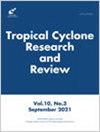超级台风八城(2024)预报面临的挑战
IF 4.1
4区 地球科学
Q3 METEOROLOGY & ATMOSPHERIC SCIENCES
引用次数: 0
摘要
八城(2024)是继“威马逊”(2014)之后,2024年又一次登陆海南文昌的超强台风,其破坏力刷新了海南台风灾害的历史记录。基于多源观测资料和数值模式预报结果,介绍了超强台风八木的特点,并讨论了其路径和强度的业务预报面临的巨大挑战。“八城”在南海东北部发生爆炸强化,24 h内风速增加28 m s−1,达到极快速强化(ERI)标准。超强台风强度持续67 h,飓风级大风(>32.7 m s−1)持续影响海南陆地面积约10 h,这些特征超过了超强台风威马逊的特征,给业务预报带来了很大挑战。实际数值天气预报模式对八木早期路径的预测存在明显差异。后期,ECMWF和盘古模式预测台风将在海南东北部登陆,NCEP-GFS和三个CMA模式预测台风将在雷州半岛登陆。考虑到历史上广东的登陆概率远高于海南,这种差异大大增加了确定登陆位置的难度。由于超强台风在海南的罕见登陆以及NWP模式对其强度的预测偏低,八木的强度预报也面临着很大的挑战。本文章由计算机程序翻译,如有差异,请以英文原文为准。
Challenges in forecasting super typhoon Yagi (2024)
Yagi (2024) is another super typhoon that made landfall in 2024 in Wenchang, Hainan, following Rammasun (2014), with its destructive power setting a new historical record for typhoon disasters in Hainan. Based on multi-source observational data and numerical model forecast results, we present the distinctive characteristics of Supertyphoon Yagi and discuss the huge challenges in the operational forecasting of its track and intensity. Yagi underwent explosive intensification over the northeastern South China Sea, with wind speeds increasing by 28 m s−1 within 24 h—meeting the criteria for extreme rapid intensification (ERI). It maintained supertyphoon intensity for 67 h, with hurricane-force winds (>32.7 m s−1) persistently affecting Hainan's land area for approximately 10 h. These characteristics exceeded those of Supertyphoon Rammasun and pose great challenges in operational forecasting. Operational numerical weather prediction (NWP) models show marked disagreements in predicting the track of Yagi in the early stage. In the later period, while the ECMWF and Pangu model predictions suggest landfall over northeastern Hainan, those of the NCEP-GFS and three CMA models maintain a landfall over the Leizhou Peninsula. Given the fact that historically, the landfall probability in Guangdong is much higher than that in Hainan, such discrepancies considerably increased the difficulty in determining the landfall location. The forecasting of Yagi’s intensity also poses a substantial challenge because of the rare occurrence of supertyphoon landfall cases in Hainan and the underpredicted intensities from the NWP models.
求助全文
通过发布文献求助,成功后即可免费获取论文全文。
去求助
来源期刊

Tropical Cyclone Research and Review
METEOROLOGY & ATMOSPHERIC SCIENCES-
CiteScore
4.60
自引率
3.40%
发文量
184
审稿时长
30 weeks
期刊介绍:
Tropical Cyclone Research and Review is an international journal focusing on tropical cyclone monitoring, forecasting, and research as well as associated hydrological effects and disaster risk reduction. This journal is edited and published by the ESCAP/WMO Typhoon Committee (TC) and the Shanghai Typhoon Institute of the China Meteorology Administration (STI/CMA). Contributions from all tropical cyclone basins are welcome.
Scope of the journal includes:
• Reviews of tropical cyclones exhibiting unusual characteristics or behavior or resulting in disastrous impacts on Typhoon Committee Members and other regional WMO bodies
• Advances in applied and basic tropical cyclone research or technology to improve tropical cyclone forecasts and warnings
• Basic theoretical studies of tropical cyclones
• Event reports, compelling images, and topic review reports of tropical cyclones
• Impacts, risk assessments, and risk management techniques related to tropical cyclones
 求助内容:
求助内容: 应助结果提醒方式:
应助结果提醒方式:


